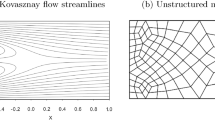Abstract
Finite-element models on unstructured meshes are frequently formulated in terms of continuous linear elements, which suffer from pressure modes and require stabilization. Alternatively, horizontal velocities may be represented with linear nonconforming elements. While the latter formulation uses three times more degrees of freedom for the velocity, it does not support pressure modes. The effects of stabilization are estimated by comparing the performance of continuous linear and nonconforming versions of the finite-element ocean circulation model (FEOM) in two simple configurations: a Munk gyre and baroclinic turbulence in a zonally reentrant channel. It is shown that, outside the free slip boundary layers, the presence of stabilization does not lead to noticeable effects if its strength is kept within certain limits. In order to evaluate the performance of FEOM, the baroclinic turbulence test is repeated with the MIT general circulation model (MITgcm), which serves as a benchmark, and reasonable agreement between different model codes is found. The two versions of FEOM have a similar computational cost, but both are significantly slower (per node) than the regular-mesh MITgcm. The paper also provides a brief description of the implementation of the nonconforming version of FEOM.
Similar content being viewed by others
References
Carrère L, Lyard F (2003) Modeling the barotropic response of the global ocean to atmospheric wind and pressure forcing—comparisons with observations. Geophys Res Lett 30:1275
Cassuli V, Walters RA (2000) An unstructured grid, three-dimensional model based on the shallow water equations. Int J Numer Methods Fluids 32:331–348
Chen C, Liu H, Beardsley RC (2003) An unstructured grid, finite-volume, three-dimensional, primitive equations ocean model: applications to coastal ocean and estuaries. J Atmos Ocean Technol 20:159–186
Codina R, Soto O (1997) Finite element solution of the Stokes problem with dominating Coriolis force. Comput Methods Appl Mech Eng 142:215–234
Codina R, Zienkiewicz OC (2002) CBS versus GLS stabilization of the incompressible Navier-Stockes equations and the role of the time step as the stabilization parameter. Commun Numer Methods Eng 18:99–112
Danilov S, Kivman G, Schröter J (2004) A finite element ocean model: principles and evaluation. Ocean Model 6:125–150
Ford R, Pain CC, Piggott MD, Goddard AJH, de Oliveira CRE, Uplemby AP (2004) A non-hydrostatic finite-element model for three-fimensional stratified flows. Part I: model formulation. Mon Weather Rev 132:2832–2844
Fringer OB, Gerritsen M, Street RL (2006) An unstructured-grid, finite-volume, nonhydrostatic, parallel coastal ocean simulator. Ocean Model 14:139–173
Hanert E, Le Roux DY, Legat V, Deleersnijder E (2005) An efficient Eulerian finite element method for the shallow water equations. Ocean Model 10:115–136
Le Roux DY, Sène A, Rostand V, Hanert E (2005) On some spurious mode issues in shallow-water models using a linear algebra approach. Ocean Model 10:83–94
Lynch DR, Ip JTC, Naimie, CE, Werner FE (1996) Comprehensive coastal circulation model with application to the Gulf of Maine. Cont Shelf Res 16:875–906
Marshall J, Adcroft A, Hill C, Perelman L, Heisey C (1997) A finite-volume, incompressible Navier-Stokes model for studies of the ocean on parallel computers. J Geophys Res 102:5753–5766
Pain CC, Piggott MD, Goddard AJH, Fang F, Gorman GJ, Marshall DP, Eaton MD, Power PW, de Oliveira CRE (2005) Three-dimensional unstructured mesh ocean modelling. Ocean Model 10:5–33
Pedlosky J (1996) Ocean circulation theory. Springer, Berlin Heidelberg New York
Stuhne GR, Peltier WR (2006) A robust unstructured grid discretization for 3-dimensional hydrostatic flows in spherical geometry: a new numerical structure for ocean general circulation modeling. J Comput Phys 213:704–729
Walters RA (2005) Coastal ocean models: two useful finite-element methods. Cont Shelf Res 25:775–793
Wang Q, Danilov S, Schröter J (2008a) Finite element ocean circulation model based on triangular prismatic elements, with application in studying the effect of topography representation. J Geophys Res 113:C05015
Wang Q, Danilov S, Schröter J (2008b) Comparison of overflow simulations on different vertical grids using the finite element ocean circulation model. Ocean Model 20:313–335. doi:10.1016/j.ocemod.2007.10.005
Westerink JJ, Luettich RA, Blain CA, Scheffner NW (1992) ADCIRC: an advanced three-dimensional circulation model for shelves, coasts and estuaries; report 2: users manual for ADCIRC-2DDI. Contractors report to the US Army Corps of Engineers. US Army Corps of Engineers, Washington D.C.
White L, Deleersnijder E, Legat V (2008a) A three-dimensional unstructured mesh shallow-water model, with application to the flows around an island and in a wind driven, elongated basin. Ocean Model 22:26–47
White L, Legat V, Deleersnijder E (2008b) Tracer conservation for three-dimensional, finite element, free-surface, ocean modeling on moving prismatic meshes. Mon Weather Rev 136:420–442
Zhang Y, Baptista AM (2008) SELFE: A semi-implicit Eulerian-Lagrangian finite-element model for cross-scale ocean circulation. Ocean Model 21:71–96
Zhang YL, Baptista AM, Myers EP (2004) A cross-scale model for 3D baroclinic circulation in estuary-plume-shelf systems: I. Formulation and skill assessment. Cont Shelf Res 24:2187–2214
Zienkiewicz OC, Taylor RL (2000) The finite element method. V. 3. Fluid dynamics. Butterworth–Heinemann, Oxford
Author information
Authors and Affiliations
Corresponding author
Additional information
Responsible Editor: Eric Deleersnijder
Rights and permissions
About this article
Cite this article
Danilov, S., Wang, Q., Losch, M. et al. Modeling ocean circulation on unstructured meshes: comparison of two horizontal discretizations. Ocean Dynamics 58, 365–374 (2008). https://doi.org/10.1007/s10236-008-0138-5
Received:
Accepted:
Published:
Issue Date:
DOI: https://doi.org/10.1007/s10236-008-0138-5




